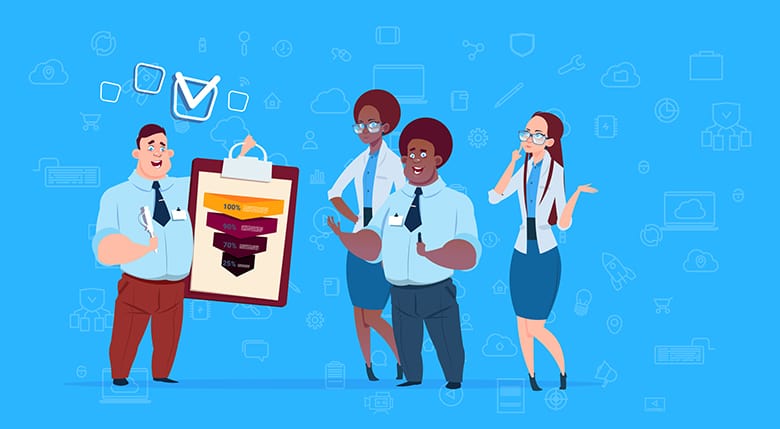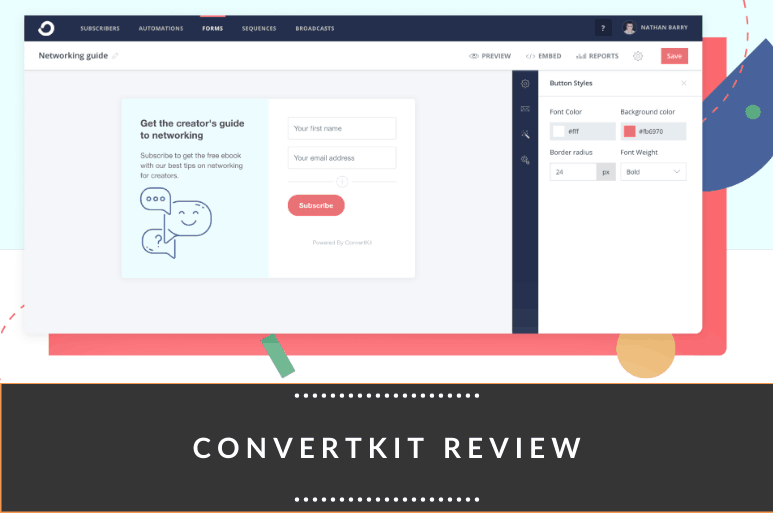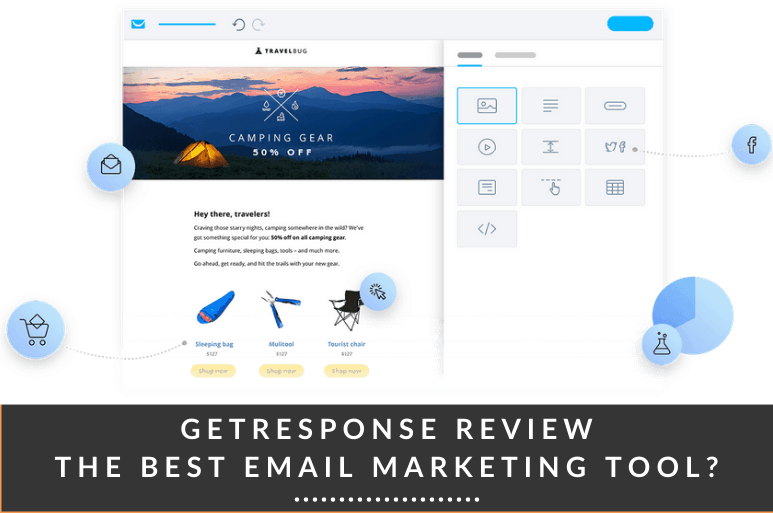Recently, I decided to take a staycation. I booked a room at the Langham Hotel and had the best time in a long, long time. Everything was exquisite, from the room service to hotel amenities to the in-room dining.
But I believe what made the experience extraordinary was how perfectly timed the staff interacted with me. They offered the right services at the right time and made the right recommendations to match my preferences.
Hands down, I’d go there again and recommend it to everyone I know.
Now wouldn’t that be great if your customers felt the same way about your brand?
Let me tell you a little secret.
An email drip campaign can help you do exactly that and more.
Through a series of emails, you can hold the hand of people interested in your brand and guide them through the customer buying journey.
Sending valuable content at timely intervals to subscribers is an excellent way to nurture your leads. Over time, they’ll begin to trust you as a reliable source of information.
More importantly, when they’re finally ready to buy a product like yours, they’ll come to you first, even if it’s months or years later.
If you want to learn how to build successful email drip campaigns and see how they can help your business, you’ve come to the right place.
But before we dive into these details and study various drip campaign examples, let's cover the basics.
What Are Email Drip Campaigns?
Think of drip marketing campaigns as a way for you to get the right information at the right time to anyone who signs up.
But an appropriate definition of email drip campaigns would be as follows – a series of pre-written, automated emails that companies can use to deliver helpful information in front of their subscribers, such as updates, notifications, etc.
For instance, as soon as someone enters their email address on your website, a welcome email is sent. A series of messages are then delivered over the next couple of weeks or until they make a purchase.
So automated drip campaigns can be triggered by:
- Dates that matter to your audience, such as birthdays, anniversaries, or other events
- Actions someone takes (or doesn’t take), such as a sign up, first purchase, email unopen, abandoned cart, unsubscribe, etc.
Either way, your emails accompany prospects through the sales funnel.
There are multiple ways you can use drip campaigns.
For example:
- Welcome email drip campaigns introduce your brand to anyone who joins your email list.
- Onboarding email drip campaigns provide subscribers content based on actions they take.
- Educational email campaigns help educate potential customers about your product line, uses, benefits, and real-life users.
- Promotional email campaigns allow you to present cross sell offers, discounts, and upgrades to relevant customers.
- Re-engagement email campaigns reignite communications with those who’ve stopped engaging with you.
So essentially, an email drip campaign allows businesses to nurture leads subtly, creating awareness about the brand and arousing interest in what they have to offer.
Eventually, these leads are driven towards a purchase. And if all goes well, you may be successful in encouraging them to repurchase several times later on.
Needless to say, an email drip campaign is every marketers priority.
How can your business benefit from a drip email campaign?
Let’s discuss this in more detail.
Benefits of Using Email Drip Campaigns
I’ll give it to you straight – drip emails can take your email marketing campaign to the next level.
Here are just a few ways how.
1. Saves Time
Imagine having to write an email to everyone who signed up to your list.
On top of that, you have to write an email every few days to keep prospects interested in your brand.
And THEN imagine writing a different one depending on user actions and interests.
This is where marketing automation software can help.
Since a drip is an automated email, your marketing team doesn't have to focus on what content to send and when to send it.
Furthermore, automation helps streamline tasks, giving your employees more time to focus on more important tasks.
2. Improves Lead Nurturing Campaigns
Research shows that 50% of leads are not ready to buy something right away.
What does this mean to you?
Half of your target audience needs to be nudged in the right direction.
So no matter how hard you try to promote your product, it won’t do much to this segment. You need to convince them slowly, with continuous interactions.
Through a series of emails, you can help leads learn about your brand, build their trust, and drive them closer to making a purchase.
3. Creates a Continuous Conversation
People have thousands of contacts and their inboxes are overflowing with content. So how do you remain at the top of their minds?
A drip campaign is a great way to keep conversations ongoing between you and your subscribers.
Since emails are created in advance and then sent at timely intervals with marketing automation, you interact regularly with your target audience and make it hard for them to forget your brand.
Look at it this way.
If a friend from high school calls you every month, would you remember their name?
Yeah, of course! Heck, you’d probably know the name of their spouse, children, and dog.
But can you say the same for a friend you’ve never called since your high school graduation? Honestly, there are a few classmates that I can’t recall simply because we never kept in touch.
Do that to your subscribers and you’re losing potential customers.
4. Enhances Your Communication Strategy
Some days you’re lucky – an interested prospect becomes a buyer right away.
But most of the time, you need to work on converting your subscriber into a paying customer without being salesy or pushy. Nor can you drown them with content, hoping that things will eventually work themselves out.
You need to give each individual space and time to reach a decision at their own pace. And the best way to do that is to send them relevant, targeted email drips that not only engages the reader but also lays the foundation for a long-term relationship.
Through drip marketing, you can keep track of your customers’ behavior and preferences. This ensures you develop and maintain healthy communication channels with all your potential customers.
5. Facilitates Segmentation Efforts
As a savvy digital marketer, you know everyone is at a different stage in the buyer’s journey.
That’s why drip marketing is so important.
Remember, it’s all about relevance and timing. By monitoring your subscriber’s behavioral triggers and metrics, you can segment your email list so that they interact better with your messages.
With the help of data-driven lifecycle emails, you can send ultra-relevant messages at the right time depending upon whether the person is a prospect, first-time buyer, repeat customer, or a lapsed customer. By monitoring their actions over time, you will be able to tell exactly when they are ready to buy.
So placing subscribers into different funnels significantly increases engagement. It’s one of the secrets behind low unsubscribe rates, better response rates, and higher conversion rates.
Moreover, you can’t group all your subscribers into one drip campaign.
For example, repeat customers are past the awareness phase. They’ve already made purchases in the past. So you can offer them a promotional drip.
On the other hand, new subscribers need more time to learn about your products and services before they’re ready to buy from you.
Do you want to take a wild guess at how effective segmented drip email campaigns can be?
You may want to sit down for this one.
Segmented drip emails can drive 18x more revenue than broadcast emails.
Moreover, since your audience segments are already interested in a particular topic or product, you’ll be able to move them more quickly through the sales cycle.
6. Generates Better Email Marketing Results
I know I had you at 18x the revenue, but there are other ways drip campaigns can amplify your marketing efforts.
For instance, research indicates that a new subscriber is most engaged in the first 48 hours.
That means you need to send a welcome email. But a follow-up campaign such as a series of onboarding emails generate great results. Studies show that open rates are 80% higher than single email sends.
But guess what? It’s not only about building relationships, nurturing leads, and guiding prospects through the sales funnel naturally.
With the help of marketing automation and email drip campaigns, you can experience a dramatic improvement in your conversion rate.
Statistics highlight that lead nurturing programs like email drip campaigns can create 50% more sales-ready leads at 33% lower cost.
I’d say that’s a winning combination! Now you can get more leads, boost sales, and save money.
This puts most other email marketing strategies to shame – drip campaigns are better for your users, your business, as well as your email marketing team!
7. Personalizes Interactions
Every email or link that a subscriber responds to offers valuable insights about their interests and builds their profiles. Now you can create deeply personalized campaigns that align with their preferences.
So rather than emailing everyone the same message, you can send more appealing and engaging content that pushes each subscriber further down their funnel.
For instance, by measuring how engaged a subscriber is with your emails, you can understand their pain points and interests.
This opens up opportunities for you to:
- send targeted, relevant content
- build their trust
- offer suitable solutions to their problems and answer their questions
- connect with potential customers at the right time
How to Create Your Own Drip Campaign
So yeah, I think you get the idea. Drip campaigns should be part of your email marketing efforts. It’s way better than sending subscribers a bunch of emails that they didn’t sign up for.
I bet you’re thinking about how you can set up a drip campaign as soon as possible. It’s never too late to get your drip-based marketing strategy started.
Here are five simple steps to get your drip marketing campaign off the ground.
1. Select a Trigger
You already know that user actions or specific dates can set off triggers in your drip marketing campaign to kick start email automation.
So what specific action or date will trigger this particular drip campaign?
For example, you can use date-based marketing automation that is triggered by subscription renewal dates.
Look at the following example. An automated email is sent before the subscription expires to notify users that their subscription will be renewed automatically. It’s a great way to reinforce the brand value and prompt a repurchase.
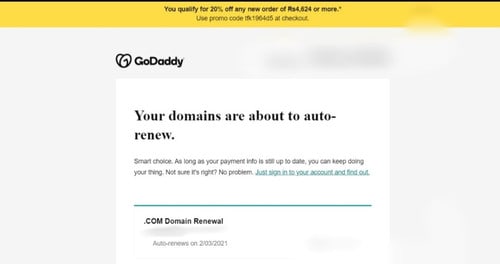
2. Identify Your Audience
Drip email campaigns are effective when you break down your subscriber list and send targeted emails to them.
Tracking the behavior of your target audience helps segment the users and personalize content so you can send information they need at the right time.
Aspects such as how long have they been a subscriber, visit frequency, the likelihood of clicking on a CTA, etc., will influence what messages you email them.
For example, content needs to be more educational when dealing with a new audience than for ones that you have interacted with before.
Every automated email campaign needs to start with your users in mind and what content, blog posts, or products they may need at their current stage.
3. Craft Your Emails
Remember, you’re reaching out to a specific segment of your users that have set off a trigger. What do you want them to do or learn?
Create a short message that is clear, grabs their attention, and encourages the reader to take action, just like the one below:
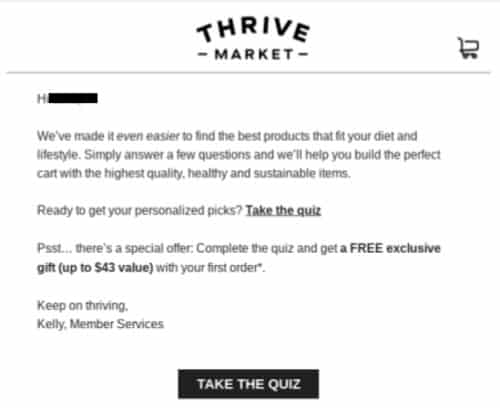
While the design is not too important at this stage, maintain the elements that build your brand’s identity, such as the voice, logo, etc.
More importantly, ensure that each email in your campaign is related to the trigger.
4. Outline Your Campaign
Like all marketing campaigns, your email drips must have a defined outline.
How many emails will be used, what’s the sending schedule, and what will be the message in each sequence are answers you have before launching the first drip.
So how many emails should be part of your drip campaign?
Well, that varies depending on the industry and customer personas. But on average, most of them usually have about 3 to 15 emails. However, the key is to space them out over a few days – anywhere between 1 – 14 days is fine.
5. Monitor Your Campaign
Once you start a drip campaign, you need to measure its success. For instance, is the conversion rate or click-through rate as high as you anticipated?
To ensure your drip campaign is successful, choose the right metrics to measure your success. This will allow you to evaluate and tweak it to generate the best results.
Drip Campaign Types
Now that you have a good idea of how an email drip campaign can benefit your business and how to set one up, you need to start exploring your options.
As mentioned earlier, there are several types you can use. I’ve discussed a few email drip campaign examples below to give you an idea of how you can use different drip sequences in your next marketing strategy.
Moreover, I’ve also offered some tips to help you generate better email marketing results.
Ready to get started?
1. Welcome Emails
Doesn’t it feel nice when you arrive at a party and the host receives you at the entrance? Then they go the extra mile to make sure you’re comfortable all throughout the event.
Your welcome email can do the same.
With the help of an autoresponder, you can meet and greet every new subscriber who signs up for your email newsletters, downloads a whitepaper, or registers for a webinar.
Ideally, this is the perfect way for you to introduce prospects to your business and say hello. But you can also use this opportunity to provide special offers, a free trial, or list your most-shared blog posts to jumpstart engagement.
Remember that this is the beginning of a new relationship. Studies show that welcome emails are read 42% more often than other promotional emails. So make sure your welcome email makes a killer first impression.
See how GAP rewards this subscriber for signing up with an extra 20% off on their first purchase.

Tip:
A welcome email needs to engage with new subscribers. A great way to do that is to send one as soon as a user signs up. Research shows that this aspect can make the open rate jump to 88.3%.
2. Onboarding Emails
If your welcome emails generated a lot of engagement, you’re off to a good start. But you need to keep the momentum going.
Now’s the time to take your relationship further with valuable, relevant follow-up messages delivered at regular intervals.
Onboarding emails are aimed at driving newcomers further into the funnel. So you need to offer content that aligns with their sign-up intent.
For instance, if someone is interested in a free trial, you need to show how to use your product or service, explain how it can benefit the user, what problems it can resolve, and even possible upgrades that can improve their experience.
Let’s take a look at the onboarding emails I received when I signed up for a free GroovesFunnel plan.
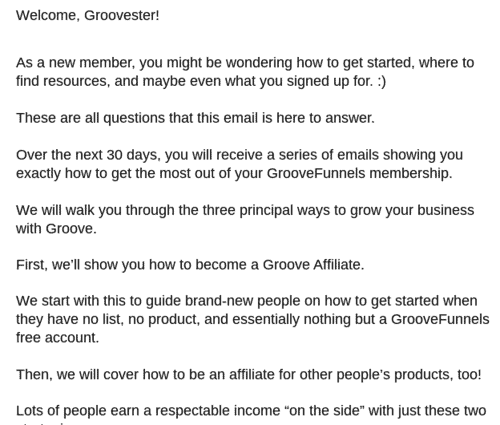
After the welcome email, as promised, I got an email every day helping me understand everything the platform had to offer and get comfortable using it. They even offered me a guided tour of how to join the affiliate program. Talk about great UX!
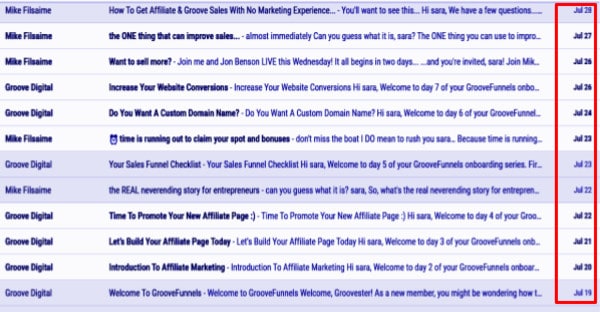
As you can see, the marketing team took the time to personalize their emails to enhance the onboarding process.
Moreover, since these campaigns drip information slowly, each onboarding email covered only one topic and had one link that directed me to the landing page where they wanted me to be.
This ensures that free-trial users understand all the features and learn how to use the platform. Once users are comfortable, the chances of them buying the premium package increases.
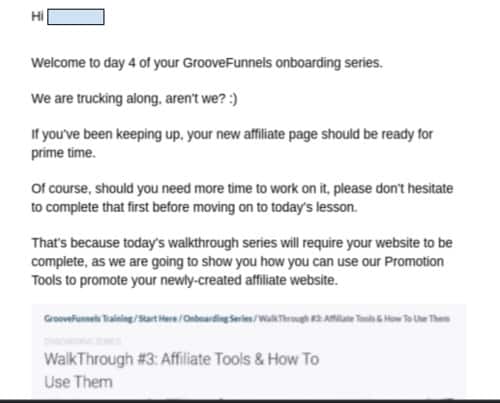
Tip:
When you set up an onboarding drip campaign, make sure to send content based on the subscriber’s activity – or inactivity. This helps to create a good initial experience with your brand and. And when users are happy, they’ll readily offer positive reviews and referrals.
Additionally, it’s a great way to convert trial users into paying customers.
3. Re-engagement Emails
There are several ways to use a re-engagement email campaign. But their main purpose is to pull potential prospects and customers back into the funnel.
For instance, re-engagement emails can reignite communications with subscribers who had signed up to your list but seemed to have lost interest in your brand.
Let’s take a look at the email sequences that Sketchers sent to re-engage with me. I was opening their emails but failing to click.
They offered me a 25% discount on my first online purchase, which I didn't use.

The second email was sent a few days later informing me that the discount would expire soon, creating a sense of urgency.

When I failed to use their coupon, they sent me another email to entice me to send them my phone number. That way, I could receive and use special discounts or rewards via phone. After all, the goal of your marketing campaign is to create multiple touchpoints and connect with subscribers in any way they want.
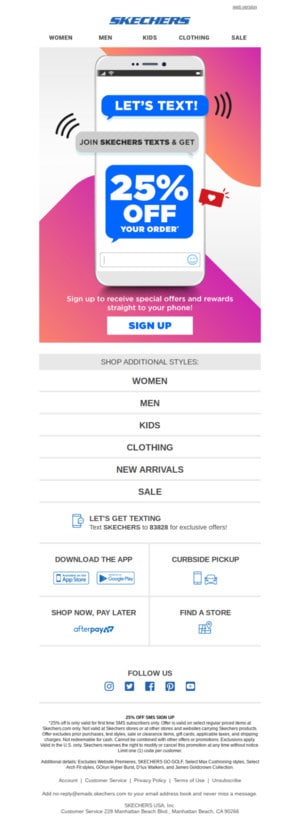
As you can see, re-engagement emails encourage engagement. So another effective way to use them is to send an automated email on the subscriber’s birthday or the anniversary of when they joined your email list.
It's an excellent way to boost your conversion rate and consumer loyalty.
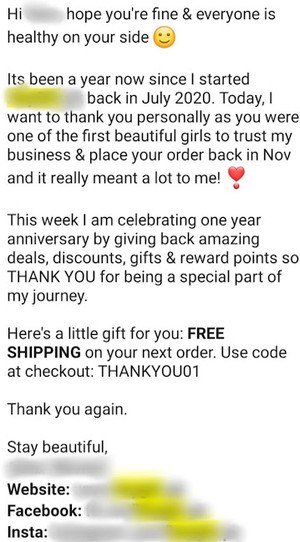
Tip:
You can also use this type of drip campaign to re-engage with customers even after they make a purchase. For example, you can send them information about related products by suggesting a cross sell or upsell. Ecommerce brands do this all the time.
However, you can send an email with a discount to any customer who hasn’t interacted with you in a while. But I’ll discuss this in more detail in the following drip campaign example.
4. Win-Back Campaign
New customer acquisition costs are rising – nearly 50% in the past five years.
So every seasoned marketer will tell you how important it is to hold onto your customers. Why?
Simply because it costs nearly 5x more to acquire a new customer than to retain an existing one. Moreover, an existing customer will make more repeat purchases (31% more), while 50% are likely to try new products that you launch.
So if you plan on increasing profits, you’ve got to work on customer retention. And an email drip campaign can help.
For instance, what if your loyal customer decides to leave because they found a better product or service? Or what if they feel they don’t need your product anymore?
You can try to re-engage with a win-back drip campaign.
Notice how this email reminds the subscriber of the benefits they had during their subscription and mentions why they should come back to their brand.
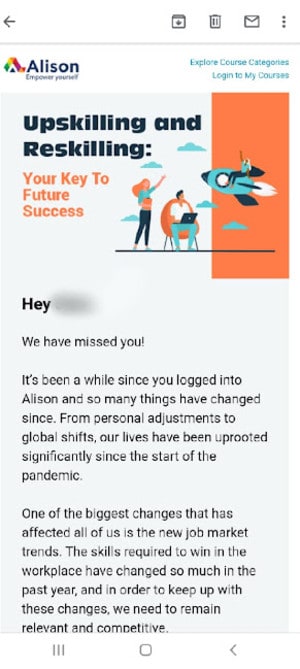
To make inactive subscribers interested in your brand again, send a drip email campaign highlighting recent upgrades in your product or service to persuade them to reconsider returning.
Tip:
Win-back drip campaigns can also be used when someone unsubscribes to your newsletter or subscription service, such as a gym membership. In the first drip, ask for feedback to help you understand why they unsubscribed.
After a couple of months, you can offer an incentive to woo them back like a discount coupon.
This company is giving a personalized, attractive promotional offer that the subscriber can’t ignore – 20% off for a limited time only.
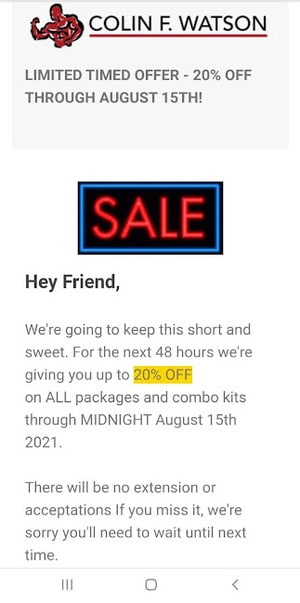
5. Abandoned Cart Emails
It happens to the best of us – shopping carts simply get abandoned. A whopping 67.45% of shoppers click on the ‘Add to Cart’ CTA but don’t complete a purchase.
But after putting so much effort into convincing people to shop at your store, this is not the time to give up on them.
It’s time to start re-engaging with your wavering customers and help them cross over.
This is an email I received to remind me of items I had considered buying but didn’t.
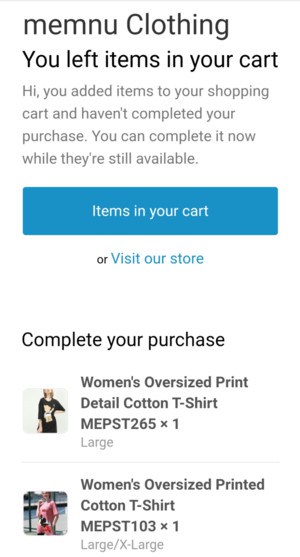
But the timing of this email is everything.
According to research, 72% of shoppers who abandon a shopping cart complete a purchase when returning within 24 hours of abandonment.
Through automated prompts, you can pull your potential customer back into the sales funnel.
So perhaps you could send a drip a couple of hours after a cart is abandoned, possibly at lunchtime or early evening when they are more likely to open the email. After all, abandoned cart emails are rather successful, averaging a 46.1% open rate and a 13.3% click-through rate.
Of course, some customers may need several reminders before they are ready to checkout. But make sure to take a balanced approach.
Tip:
Try to limit the use of CTAs in your abandoned cart emails. The more choices you give your leads at this stage, the more distracted they’ll get and are less likely to take action. Ideally, one clear, strong CTA is enough.
6. Confirmation Emails
Closing a sale doesn’t mean your drip campaigns are done. It’s time to use another drip campaign to confirm a purchase or subscription renewal and continue engaging with your customer.
The best way to begin is to set up a “Thank you” autoresponder to send an email right after a purchase. This is precisely how Amazon started its email drip campaign after I made a purchase.
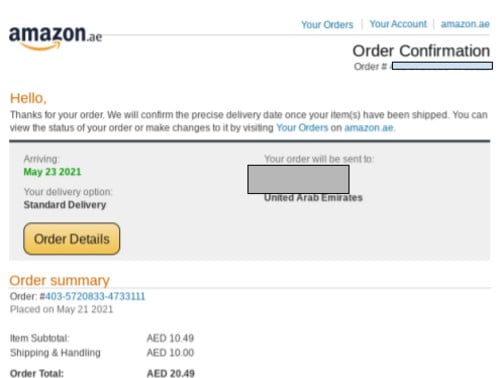
Then they continued to send me updates about my order until it was delivered to my address.
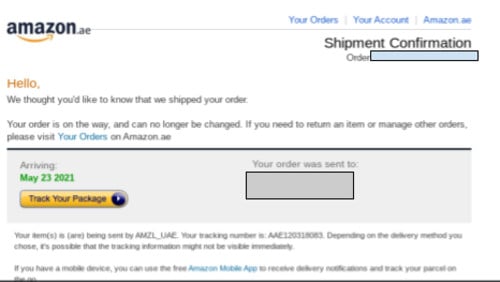
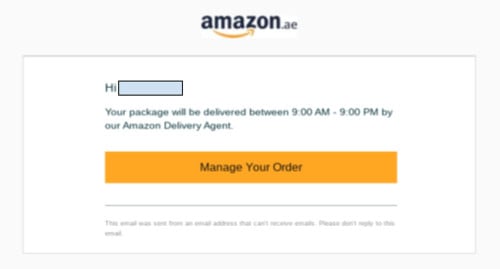
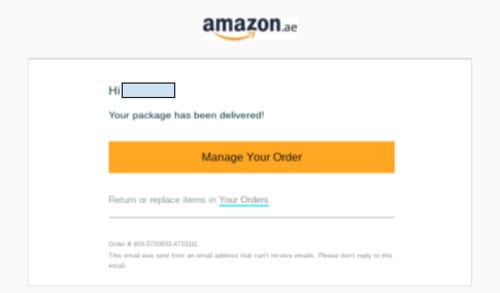
Tip:
Think of a confirmation email drip campaign as yet another opportunity to keep customers engaged with your brand beyond the purchase. Product recommendations in these drips are great ways to boost sales and revenue.
So it’s not surprising that along with a short ‘We hope to see you soon’ message, Amazon uses this call to action to drive shoppers back to their website with the hopes that they may make a purchase again.

But you could do something a little different.
For instance, ask your customer to send a review of the product they purchased or reward them with a special discount that’s redeemable on their next shopping spree.
Even though there are several other email drip campaign examples I’d like to discuss, I think we need to delve deeper into the topic.
If you’re still reading this blog, I bet the next thing on your mind is how can I make my drip marketing campaigns even better?
Great, because I’ve got some ideas that can take your current efforts to the next level.
Email Drip Campaign Best Practices
I know you want to learn simple and easy ways to tweak your drip email campaigns. So let’s get down to business.
Here are some best practices you should implement.
1. Create Powerful Landing Pages
Email drip campaigns and landing pages work together in your sales funnel.
A list of subscribers is generated from a lead-generating landing page. As people enter the drip campaign, a series of emails are sent to convert them into buyers.
Inadvertently, receivers are sent to another landing page where they can get more information to make a buying decision.
So think of your landing pages as the gateway to conversions. A well–designed landing page will engage visitors, helping to boost sales.
Your email drip campaign will only be as effective as your email list – for tips on growing your list, check out this article.
2. Follow Email Subject Line Guidelines
As part of email marketing, your drip campaign will only be successful if your emails are packed with dynamic features. A well-crafted subject line will help grab a reader’s attention and boost the open rate.
Here are few tips for creating a compelling subject line:
- Use action verbs
- Arouse intrigue, urgency, curiosity, etc.
- Limit subject lines to 30 – 50 characters
- Offer an irresistible value proposition
3. Keep Initial Messages Short and to the Point
There are times when you will need to create longer emails.
However, subscribers shouldn’t feel like they’re wasting their time. So send informative, valuable content, but avoid using too much marketing language and talking about your product.
Keep the introduction short, no more than a couple of sentences. Explain what the purpose of the email is.
Drip emails go out frequently so you don’t need to worry about giving away everything in one go.
4. Create a Clean Layout
Short paragraphs with adequate white spaces make emails easy to read, especially on small devices.
5. Include a CTA in Your Drip Emails
Not all drip emails need a CTA. But whenever you do use one, make sure it’s prominent and easy to click.
The call to action should be clear so that readers understand what they are agreeing to and what they should expect in the next stage of their journey.
Always include an unsubscribe CTA so that subscribers have an easy way to leave when they want to. This prevents your drips from landing in the spam folder.
6. Understand Where the Subscriber Stands in the Customer Journey
Your drip emails need to be relevant to subscribers as they travel through the sales funnel.
A new subscriber needs to be nurtured before they’re willing to interact with promotional messages.
Moreover, you must modify the content to align with your target audience’s needs and pain points.
7. Space Out Drip Email Flows
To create consistency in the content of all your drip emails, write them at the same time. However, send them to subscribers at timely intervals.
Remember, a perfect email drip campaign is one where subscribers are happy to receive content from you. So give your subscribers time to read and take in the message.
That means you need to space out your emails appropriately – too close together, you’re at risk of overwhelming them, and too far apart, they could forget who you are.
Drip campaigns are all about pacing yourself and not rushing things.
8. A/B Test Drip Marketing Campaign Results
A/B testing is a great way to fine-tune and optimize your current drip email campaigns.
So experiment with different subject lines, CTAs, offers, send schedules, styles, etc., to find the best conversion rate.
More importantly, check that emails display well on mobile screens to reduce unsubscribes.
It’s a Wrap on Drip Email
Email marketing drip campaigns have a lot to offer for your business. However, only a well-thought-out strategy can make a difference.
You should begin by recognizing what your subscribers need at each stage of their buying journey. This will allow you to engage with them and build better relationships. And that means sending the right emails at the right time to your target audience.
But more importantly, to ensure your drip email campaign hits right off the bat, maintain email list hygiene. That way, you’ll only be sending emails to people who want to hear from you.
I guess, now you know all my secrets of high-converting, successful drip campaign emails. So it’s time you started planning your next marketing strategy and implementing the ideas mentioned above.
But don’t be afraid to experiment with new ways to deliver content to prospects and nudge your leads towards the intended goal.

